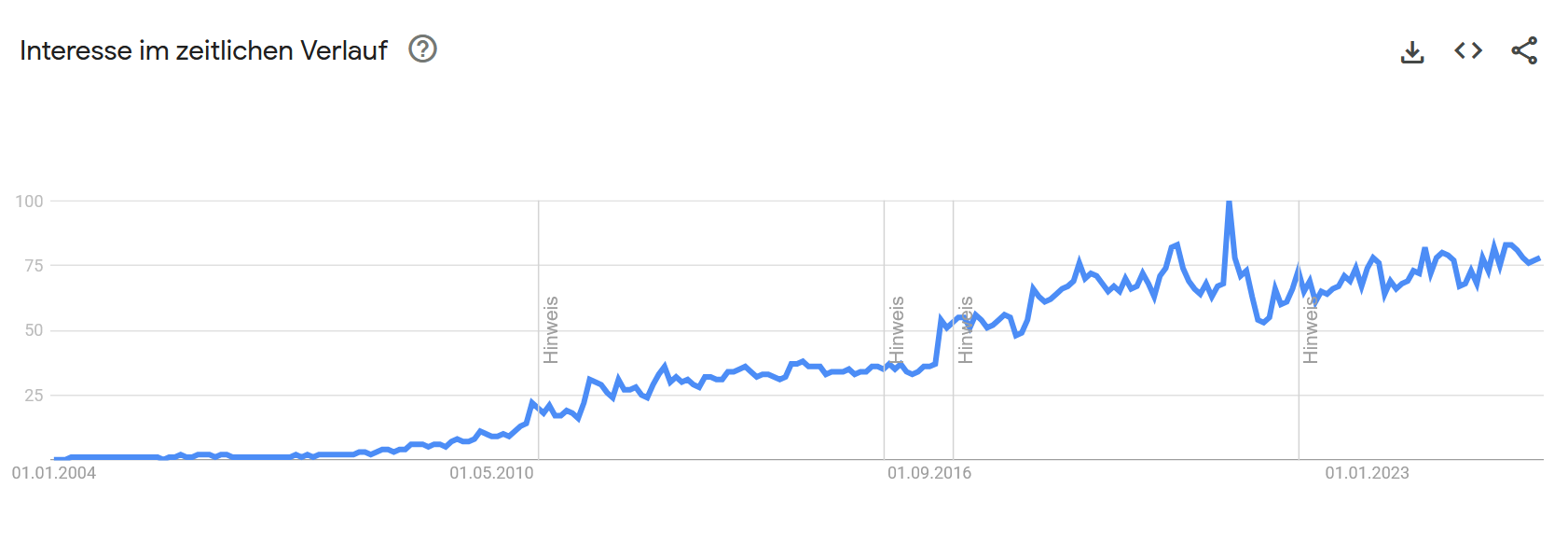According to Google Trends, the topic of cloud computing reached its highest search volume in December 2020 and has maintained a consistently high level of interest ever since. In light of current challenges—from the growing influence of large AI models to increasingly extreme peaks and troughs in the global flow of goods—it is worth taking a look through the intralogistics lens.

What is the cloud?
The oft-quoted phrase “The cloud is just someone else’s computer” falls short. A more accurate description, in our view, would be: “The cloud is someone else’s computer that is better automated and standardized than your data processing center.” Physically, it consists of masses of inexpensive, highly networked hardware in clusters. Redundancy mainly occurs at the software level because almost every process, from provisioning to monitoring to failover, is automated. This can mean that defective components often go unnoticed for months because workloads are migrated automatically. This gives a better impression of the cloud’s performance than throwing around technical data.
Why does automation play a key role here?
Standardized interfaces (e.g., via Kubernetes APIs) enable infrastructure to be controlled via code. This makes scaling plannable and verifiable, while operations teams can focus on process and quality improvements instead of manual work on the infrastructure.
What are the requirements?
A pure 1-to-1 migration of existing servers to a hyperscaler cluster or to your own cloud hardly exploits their potential. Although virtual machines can be booted up there as usual, they scale as monolithic blocks.
An example

A company replicates its intralogistics application, such as a WMS, three times to maintain redundancy. Each instance contains all dependencies – the resource requirements multiply accordingly. According to current standards, function-specific components are instead separated into containers and orchestrated via cloud-native solutions. This allows only those software components that actually generate peak loads to be scaled, patched, or replaced.
The basics
The following basics should therefore be met for resource-efficient cloud deployment in intralogistics:
- Container and hexagonal architecture – Modular design and loose coupling simplify scaling, testing, and maintenance.
- DevOps principles – Close integration of development and operations shortens release cycles and ensures quality.
- Knowledge of market-leading standards – Kubernetes, AWS, Google Cloud Services, and others form the foundation for portability and automation.
The advantages
If the basics are right, computing power becomes a scalable resource that only incurs costs when it is actually needed. Infrastructure can be provisioned, expanded, or shut down at the touch of a button. Processes – such as test deployments of new software versions – no longer tie up permanent on-premises capacities, but are operated in the cloud depending on the situation. This accelerates projects and reduces fixed costs.
Other key advantages
- Fast implementation and testing of new processes – Isolated test environments can be set up in minutes and removed without leaving any traces once they are complete.
- Cost efficiency – Pay-as-you-go models avoid over-provisioning; those who already have sufficient local capacity can still shift peak loads to the cloud at a lower cost.
- Standardization & vendor independence – Open interfaces reduce lock-in risks and make it easier to switch between providers if no proprietary clusters are available.
“Never touch a running system” – but not at any price
Sooner or later, operations will require new materials handling technology, additional MDT devices, or security updates. A prominent example – because it is so long-lived – is Windows CE, whose final release was in 2023. The older the platform, the higher the risks (security vulnerabilities, lack of spare parts).
In this case, the user interfaces were still closely linked to the devices in the form of specialized software. The cloud makes it easier to switch to modern architectures and scale according to the situation: Web-based interfaces can be provided centrally and supply hundreds of devices via elastic clusters on busy shopping days, while only a fraction of the resources are running during the summer slump, thus saving budget.
Why a digression on GUIs?
Web front ends illustrate the immediate benefits of cloud scaling: instead of maintaining separate apps and update routines for each end device, a cluster delivers uniform interfaces. This added value is not exclusive to cloud environments, but it is particularly easy to implement there because scaling is so simple.
Nevertheless, high latency requirements in the millisecond range (e.g., material flow control) or strict security requirements may necessitate edge or on-premises approaches. The decision therefore always depends on the context.
Computing power as a utility
Just as electricity or water comes out of the tap as a matter of course, computing power becomes invisible in a well-automated environment: load balancing, monitoring, and self-healing run in the background, while the specialist team simply controls whether more or fewer resources are needed. This is how we think and live software.
Limits of the cloud
The cloud is not a jack of all trades. For ultra-low latencies or when data must remain physically in a secure environment, a hybrid model or an on-premises solution makes sense. However, for processes that “only” require response times in tenths of a second, the advantages of the cloud often outweigh the disadvantages.
Conclusion
The path to the cloud is becoming increasingly attractive for decision-makers: scalability, flexibility, and faster innovation cycles offer tangible advantages. However, simply moving old monoliths will only allow you to realize some of the potential. Only cloud-native architectures that combine function and infrastructure automation maximize ROI—especially in intralogistics, where load profiles range from Black Friday peaks to the summer slump.
Our other blog posts
Back to home
How we solve data collection with mobile devices